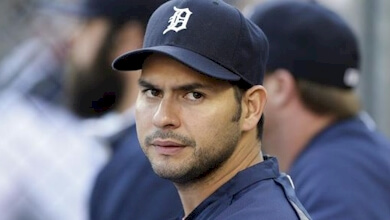
Detroit righthander Anibal Sanchez is coming off two disappointing seasons.
Warning: The “Sanchize” is no longer.
And if you’re wondering who I’m talking about, I’m taking about one Anibal Sanchez.
After recording a 4.99 earned run average and a fielding independent pitching (FIP) mark of 4.73 in 2015, can he be trusted as a top-three rotation arm for the Tigers in 2016?
I ask that question not only based on his lackluster performance last season.
It’s also based on the fact that the 32-year-old Venezuelan native has pitched in fewer than 29 games and under 180 innings each of the past two seasons (25 games and 157 innings in 2015, plus 22 games and 126 innings in 2014).
That’s simply not cutting the mustard seed for a middle of the rotation arm. To make matters worse, Sanchez has already given the Tigers an injury scare this spring.
The scare stems from soreness that he reported in his lower right triceps last week.
Although the soreness is not considered serious enough to cause “Sanchie” to miss the start of the regular season, it’s still a cause for concern for Detroit, who expects him to be its No. 3 starter in 2016 as they attempt to rebound from a last-place finish.
The righthander experienced arm troubles in the past, too.
In fact, both last year and in 2014, he missed significant portions of the season due to injury. He spent two stints on the disabled list in ’14, the last one caused by a strained pectoral muscle that resulted in him missing nearly the remainder of the season. He sat out for over a month and when he returned, he was strictly a bullpen arm, pitching in a lone game out of the pen at the end of the regular season and then in Game Two of the Tigers’ American League Division Series against the Baltimore Orioles.
He was efficient in both bullpen appearances, allowing no runs in each appearance. However, it was a disadvantage to manager Brad Ausmus that Sanchez couldn’t be used as a rotation arm in the club’s biggest games down the stretch of 2014.
The Tigers yearned for a healthier Sanchez in 2015, especially after losing 2013 AL Cy Young award winner Max Scherzer to the Washington Nationals via free agency. Yet, they got the opposite of that plus a less productive Sanchez for the duration of the ’15 campaign.
He allowed five home runs and had a 5.46 ERA through five starts in April, and by the end of May, he had allowed 12 home runs and had recorded a 5.75 ERA. He was far from on track to pitching a good season of baseball. Although Anibal did lower his ERA in June and July, he was still a long way away from being highly effective.
He only had lowered it to 4.61 by the end of July, and continued to give up the long ball at a rapid rate. In fact, he gave up 10 big flies over 10 starts in June and July, meaning he allowed, on average, one per game.
Things were certainly not on the upswing for Sanchez, either, as he surrendered seven more homers in August in only four starts before being shelved for the rest of the season with inflammation in his right rotator cuff.
Despite not starting a game after August 18th, he finished in a tie for most home runs allowed in the American League with 29. It was a far cry from his 2013 and ’14 campaigns when he allowed 13 long balls combined.
Sanchez’s 2015 ERA also ended up being his worst since his third season in the bigs (2008) when he was a member of the-then Florida Marlins and recorded a 5.57 mark in 10 starts.
Given his arm troubles and poor performances the last two seasons, there seems to be little reason to be optimistic about a starting pitcher who is over 30.
The Tigers dropped to the cellar last season largely because of the dismal showing by their pitching staff, which suffered from poor performances from key personnel as well as injuries. If Detroit is to return to contention they have to hope that Sanchez can recapture his magic from 2013 when he recorded an AL-leading 2.57 ERA. When he’s on, like he was in 2013, Sanchez can be frighteningly dominating. That season he reached double-digits in K’s in a game five times, including 17 on April 26th against the Braves, tying a franchise record. That year, Sanchez narrowly missed pitching a no-hitter in May and finished fourth in Cy Young Award voting. In Game One of the ALCS that fall, he stifled the Red Sox, pitching six hitless innings and earning the win.
What can the Tigers expect from Sanchez in 2016? Is his sore arm cause for concern? Can he stay healthy? Is he capable of regaining the form that once made him one of the better starting pitchers in the game? The answers to those questions will play a large role in the success of the team this season.


